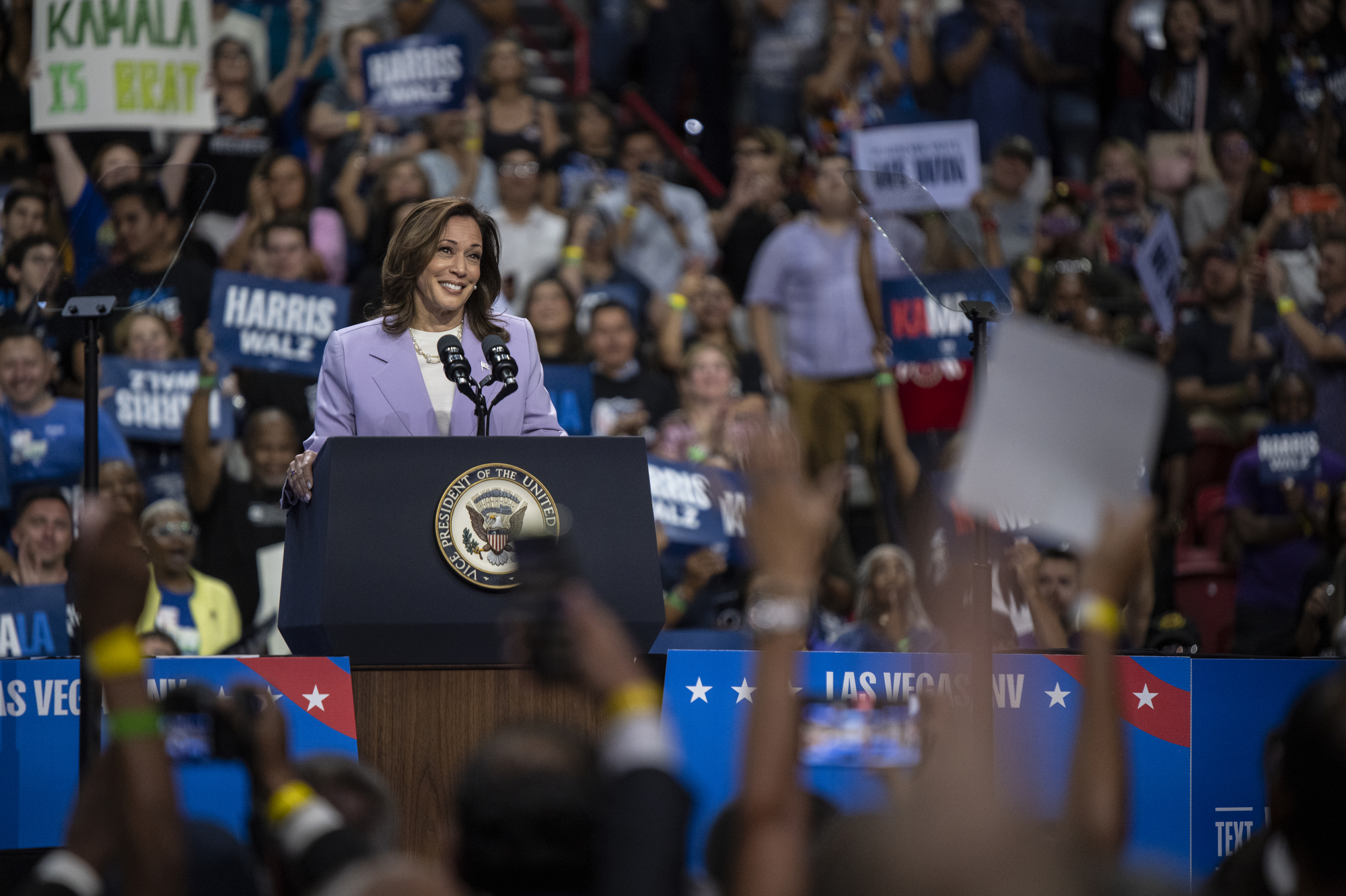Analysis: Harris banked on wide nonpartisan support in Nevada. It apparently never came.

Ever since nonpartisans became the largest share of registered voters in Nevada last year, the results of this year’s presidential election were bound to turn on how such a prominent — yet unknown — group would sway.
And based on preliminary data, they didn’t seem to break nearly as much toward Democratic Vice President Kamala Harris as she needed to offset big gains in the share of Republican registered voters since the 2020 election.
In Clark and Washoe counties — Nevada’s two urban population centers that account for nearly 90 percent of the state’s registered voters — data through Friday morning show nearly 330,000 nonpartisans voted in the election, making up more than a quarter of the areas’ turnout, according to a Nevada Independent analysis of voter file data.
Based on the assumption that Harris won 95 percent of registered Democratic votes and 5 percent of votes from registered Republicans in the two counties, she likely only received about 53 percent of the nonpartisan vote, The Indy found.
If Democrats want to turn Nevada blue again in the next presidential race, they’ll likely need to do better among nonpartisans, especially in the state’s two urban counties. Although nonpartisans turn out at lower rates than members of both major parties, they could still be a source of growing power and untapped potential because of their relatively younger age, according to interviews with experts and a Nevada Independent analysis of voter data.
As of Nov. 1, nonpartisans made up more than one-third of active registered voters in Nevada, while the share of registered Democrats and Republicans did not surpass 30 percent. Ahead of the 2020 election, nonpartisans made up just 24 percent of the state’s active registered voters, while they were about one-fifth of the active registered voters after the 2016 election.
Part of this surge is likely because nonpartisan is the default option for the state’s automatic voter registration program, which launched in 2020 and has grown the overall voter pool by hundreds of thousands of people.
Despite relatively little information surrounding the nonpartisans’ voting behaviors, Democrats were optimistic they would have a significant advantage. As early voting turnout statistics showed big leads among registered Republicans over registered Democrats, Democrats remained confident that they would do well among nonpartisans.
Jeremy Hughes, a Republican consultant, said he thought that wishcasting was misguided.
“I think Democrats just based that on gut. I didn’t see any data that back that up. I never saw it in any of our numbers, any of our models,” Hughes said.
Although it is not clear what motivated nonpartisan voters to behave the way that they did, there is still ample information about who makes up this voting bloc and where things might have shifted this year.
And because Washoe County maintained its status as a purple region this year, and rural voters backed former President Donald Trump by similar margins as four years ago, Clark County provides the best case study.
2020 comparison
Since President Joe Biden won Clark County by 10 percentage points in 2020, the share of registered Republicans in the county has shrunk slightly, while the share of registered Democrats dropped by a staggering 8 percentage points. Nonpartisans, on the other hand, soared 10 percentage points.
This points to an environment where Harris would have likely needed to outperform Biden’s share of nonpartisans to make up for the loss in Democratic registration.
Once again assuming that Harris won 95 percent of registered Democrats and 5 percent of registered Republicans, her miniscule lead in Clark County as of Friday morning meant that she likely only carried about 53 percent of the nonpartisan vote in the county. Using the same calculation in 2020, Biden likely won about 62 percent of nonpartisan voters in Clark County.
However, David Damore, a UNLV political science professor, said the question remains whether this is opposition against Democratic candidates or simply a desire for a change from the party in power.
“That's the question — is that the incumbent party effect, or is that a real partisan effect?” Damore asked.
Untapped potential?
However, because much remains unknown about the nonpartisan voting bloc, it could be a source of untapped potential for both parties.
Jeremy Gelman, a UNR political science professor, described nonpartisans as being in three groups: closet Democrats, closet Republicans and distinctive voters with no true allegiance to either party, which he estimated was about 8 percent to 15 percent of the group.
“I think parsing through where the nonpartisan voted from and what's motivating people to register as nonpartisan is the task of researchers, political journalists for the next two years,” Gelman said. “The challenge for parties is to [figure] out what is that [winnable voters group].”
The age distribution underscores the group’s untapped potential.
The more than 270,000 nonpartisan voters in Clark County this year had an average age of about 45, lower than Democrats (51) and Republicans (55), which experts said means they are likely to become more politically engaged as they age.
Additionally, the turnout rate for nonpartisans was significantly lower than for Democrats and Republicans across all ages (again, perhaps a result of people being automatically registered as nonpartisans yet having no intention to vote), but also meaning there might be room for the voting bloc to grow in political relevance. Take the graph below, as an example. Notice that the turnout discrepancy was even larger among younger voters.
Peter Koltak, a Democratic strategist in Nevada, said he is interested in learning how the nonpartisans’ behaviors varied depending on location.
“It'll be very interesting to see who they are, as best we can tell demographically, gender, age, ethnicity and race,” he said.
Greg Bailor, a longtime Republican strategist in Nevada, said winning over nonpartisans needs to be part of both parties' plans from the get-go.
“There's not a scenario where we're going to have less unaffiliated voters anytime soon,” Bailor said. “If you're going to win in a state like Nevada, they have to be part of your day one strategy.”
